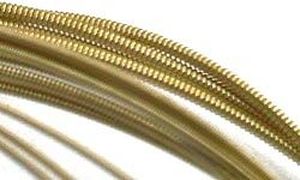3. Electric Guitar Strings
Probably the most important factor that influences the sound and performance of guitar strings is the material or materials theyre made from. Electric, acoustic and bass strings all make use of a variety of metals and alloys (well look at classical guitar strings separately). The choice of materials has a direct effect on sound, both through acoustic and magnetic properties, and also an indirect effect in terms of performance and longevity.

Nickel & Nickel Steel
The development of magnetic pickups ensured a parallel development in string technology. In the vintage years of the Fifties and Sixties, most wound strings combined a solid steel core with a nickel-alloy winding. Nickel-alloy is relatively weak magnetically, and though this can be a disadvantage in itself, it does mean that pickups can be set very close to the strings, resulting in a playing feel that some find more intimate. Nickel-alloy gradually gave way to nickel-plated steel in this period, with steels stronger magnetic properties producing a louder, more brilliant sound. Nickel-steel strings dominate the market today, though many manufacturers also produce vintage nickel-alloy strings for players seeking a warmer sound.
Stainless Steel
In the Seventies another material became popular for electric guitar strings - high-grade stainless steel. The strong magnetic properties of this material produce a brilliant, clear and loud sound. Another advantage is improved durability - stainless steel is by design much less prone to rust than nickel-steel. Stainless steel can be a little harder to manage though, as the magnetic force between strings and pickups works both ways. If the attraction is too strong, for example if the pickups are set too close, then they can exert a pull on the string which affects its natural vibration with unpredictable and generally unmusical results.
Gold
More recently, German string manufacturer Maxima have pioneered the use of gold plating on high-grade steel. This gives a brilliant and rich sound, it eliminates the effects of corrosion, and also caters for those who suffer from nickel allergy. Maxima strings are now marketed under the Optima brand.
Electric String Gauges
While there is no universal agreement between manufacturers governing the composition and naming of guitar string sets, the table below serves as a useful guide:
| E | B | G | D | A | E | |
| Extra-Light | .008 | .011 | .014 | .022 | .030 | .038 |
| Light | .009 | .011 | .016 | .024 | .032 | .042 |
| Regular | .010 | .013 | .017 | .026 | .036 | .046 |
| Medium | .011 | .013 | .020w/18p | .030 | .042 | .052 |
| Jazz | .012 | .015 | .026 | .034 | .044 | .054 |
| Baritone | .013 | .016 | .026 | .036 | .046 | .056 |
| In addition, some manufacturers offer hybrid sets. Light Top/Heavy Bottom sets are the most popular hybrid combination. | ||||||
| Light Top/Heavy Bottom sets: | .010 | .013 | .017 | .030 | .042 | .052 |
| This works well for rock players who use a lot of vibrato and bends on the upper strings, while still needing a chunky sound for power chords from the lower strings, particularly in drop D tuning. The popularity of flat tunings with metal players, where all strings are tuned down by a semitone or more, has led to the creation of heavy sets with a heavy plain G string: | ||||||
| .011- | .015- | .022p | .030 | .042 | .054 | |
| or even: | .012 | .016 | .024p | .032 | .044 | .056 |
As a general rule, heavier strings produce a louder, richer sound, but the associated higher tension is harder on the fingertips, especially for beginners, and makes vibrato and bends harder to execute. Players whose styles incorporate wide bends and florid vibrato tend to use lighter strings. At the other end of the spectrum, serious jazz players often use elevens or twelves, where higher tension is perceived as advantageous not only for its richer tone, but also because vibrato is somewhat frowned on in jazz!
Scale length also plays a part - while the difference between the short 628mm scale of Les Paul-type guitars and the 648mm Stratocaster scale may seem small, its enough to make the same set of strings feel very different.
Most players find themselves moving to heavier gauge strings as their fingers grow stronger, along with their appreciation of guitar tone. While moving to heavier strings can take time and hard work, its usually a rewarding process. Changing to a lighter gauge generally feels odd and tends to result in clumsy playing.
Your Contacts
Product Highlights
Offers
Do you like what you're seeing?






